 Pirates and Privateers Pirates and Privateers
The History of Maritime
Piracy
Cindy Vallar, Editor
& Reviewer
P.O. Box 425,
Keller, TX 76244-0425
    
Friends and
Enemies
by Cindy Vallar
Meet the friends of pirates
Patrons, Merchants, Government Officials, Women
Meet
the Enemies
Pirate Hunters, Government Officials, Witnesses,
Preachers, Victims
The Friends
Patrons
Patrons were men, and on
occasion women, who had the finances necessary to
back piratical ventures. Some also acquired
significant power and influence to protect the
pirates from the law. Jean Ango,
who lived in Dieppe, France, from about 1480 to
1551, sponsored sailing ventures that were both
legal and illegal. Through outright ownership or as
a member of a syndicate, he controlled many of the
vessels in the region. His ships attacked others
bound from the Indies, and with his earnings he
bribed bankers, judges, and military officers to
protect him and thus controlled the local
government. Eventually, he was imprisoned for
misconduct in office.
Sir George
Carey, the second Baron Hunsdon, promoted
piracy in England. The eldest son of Lord Admiral
Charles Howard’s brother-in-law and kinsman to Queen
Elizabeth I, Carey became Captain-General of the
Isle of Wright and Vice-Admiral of Hampshire. As
such, he fenced booty and other items acquired
through illegal means. Any victim who dared to seek
justice through the Admiralty Court in London lost
his case because Carey influenced or bribed the
judges. Between 1587 and 1591, he financed at least
three pirate fleets that plundered the West Indies.
The Killigrews
of Cornwall also supported piracy during the
sixteenth century. Various members of this
family fenced stolen goods, while a few actually
became pirates.
Frederick
P. Philipse was one of New York’s richest and
most politically influential merchants of the last
decade of the seventeenth century. He financed
numerous pirate ventures, including that of Adam
Baldridge’s trade with the pirates of Madagascar.
Philipse’s final shipment to St. Mary’s in 1698,
carried salt, arms (guns, pistols, muskets, knives),
gunpowder, flints, alcohol (beer, wine, rum),
looking glasses, sewing implements (thimbles,
scissors, thread, 3,000 needles), buttons, ivory
combs, cotton candlewicks, tobacco pipes, hats, and
shoes. These items were sold or traded for gold,
silks, spices, and slaves. His son, Adolphus, also
participated in the pirate brokering business.
Nor were the Philipses the only colonial
entrepreneurs to fund pirate ventures. Men just like
them lived in Philadelphia, Boston, Newport, and
Charleston. They functioned as legitimate importers
and merchants, but also brokered stolen goods.
They incorporated their fees into the value of the
cargoes pirates brought them, and then sold those
goods at a high profit.
Merchants
Merchants purchased
ill-gotten gains from pirates in hopes of making
greater profits than they could through legal means.
Some wealthier merchants openly financed pirate
expeditions. Forbidden to manufacture anything
themselves, British colonists had to import all
manufactured goods at high prices. Since pirates had
these items (especially scarce goods from foreign
countries), and the colonists didn’t have to pay
high import duties, they welcomed the pirates.
According to some estimates, pirates brought
£100,000 into New York’s economy.
Once a pirate himself, Adam Baldridge fenced and
traded with pirates for six years. He arrived on St. Mary’s
Island in Madagascar, a haven for pirates, in
early 1691, and built a trading post, a house,
storehouse, and log fortress protected by six
cannons on the small island surrounded by a lagoon.
He also erected a second fortification near the
harbor with about twenty-two guns. Pirates exchanged
gold and other booty for the supplies they needed.
Wine, for example, sold in St. Mary’s for fifteen
times its New York price. Over the next six years,
Baldridge built a lucrative business, which he sold
to Edward Welch in 1698.
Between 1697 and 1699, several merchant ships put in
at St. Mary’s laden with cargo for trade with the
pirates. Under the command of Richard Glover, Amity
arrived in May of 1697. Unfortunately, the crew
of Resolution stole the cargo, which
resulted in a loss for Amity’s owners,
the Governor of Barbados and several others. Captain
Thomas Mostyn arrived aboard Fortune in
June. When he returned to New York in 1698, he
brought with him fourteen pirates who had decided to
retire.
Port Royal,
another pirate haven, catered to many pirates during
the days of the buccaneers. One of the town’s more
genteel establishments
was Barre’s Tavern, which served “silabubus [sic],
cream tarts and other quelque choses.” (Marley) John
Starr ran the biggest brothel in Port Royal. His
girls included twenty-one whites and two blacks.
Government
Officials
Members of the government
tended to fall on both sides of the piracy issue.
Some were friends. Some proved to be enemies.
Between 1581 and 1583, Francis Hawley, an English
customs official and the deputy of Sir Charles
Christopher Halton at Corfe Castle, received stolen
merchandise from pirates. Among those were Stephen
Heynes (also known as Stephen Carless), who
often said he “had better friends in Englande then
eanye alderman or merchants of London” and William
Valentine (aka Vaughan), who once captured a cargo
of Bibles. (Rogozinski)
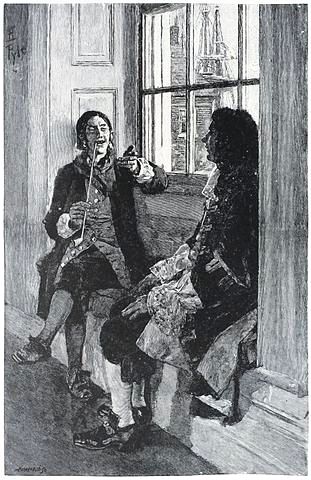 One
frequent abuse of power stemmed from the letters of
marque the colonial governors issued. Thomas Tew
received his commission from Governor Benjamin
Fletcher of New York. Fletcher, a colonel in
the English Royal Army, became governor in August
1692, and also received a two-year appointment as
the Governor of Pennsylvania and commander of the
Connecticut, Rhode Island, and New Jersey militias.
In return for the privateering commission, Tew gave
the governor a promissory note of £300 to insure
that he did nothing illegal, yet he went to the Red
Sea and captured an Arab ship laden with gold that
netted him £8,000 and each pirate £1,200. One
frequent abuse of power stemmed from the letters of
marque the colonial governors issued. Thomas Tew
received his commission from Governor Benjamin
Fletcher of New York. Fletcher, a colonel in
the English Royal Army, became governor in August
1692, and also received a two-year appointment as
the Governor of Pennsylvania and commander of the
Connecticut, Rhode Island, and New Jersey militias.
In return for the privateering commission, Tew gave
the governor a promissory note of £300 to insure
that he did nothing illegal, yet he went to the Red
Sea and captured an Arab ship laden with gold that
netted him £8,000 and each pirate £1,200.
That Fletcher, and others like him, consorted with
pirates was not a secret. Fletcher invited Tew to
dine with his family and accepted a gold watch from
the pirate. When Edward Coates wished to bring his
plundered goods into New York, Fletcher wanted £700.
Instead, Coates gave him the entire ship, which
Fletcher sold for £800. When the governor received a
reprimand for selling letters of marque to pirates,
he wrote, “It may be my unhappiness, but not my
crime if they turn pirates.” (Marx) Yet he did know,
for his wife and daughters wore silk gowns and
jewelry Tew acquired from his attack on ships of the
Mogul of India.
Governor William
Markham of Pennsylvania was a “steddy friend”
to pirates. He approved of his daughter’s marriage
to James Brown, who had sailed with Henry Every.
Markham helped his son-in-law secure a seat in the
assembly and protected him for £100. Another pirate,
Captain Sneed, paid the governor slightly more money
to become a justice of the peace. He did not,
however, prove a friend. He prosecuted pirates and
accused Markham of consorting with pirates.
Robert Livingston, an entrepreneur in New York,
assisted William
Kidd in acquiring sponsors for the
privateering voyage that resulted in Kidd being
declared a pirate and murderer. One supporter was
Lord Bellomont, a member of Parliament. The other
members of the syndicate included four lords
(Somers, Orford, Romney, and Shrewsbury) and a
director of the East India Company, Edmund Harrison.
Jacques Nepveu, Sieur de Pouançay, was the fifth
governor of Tortuga and Saint-Domingue. To revive
the economy, he granted letters of marque to pirates
on the condition that they returned to the island
with their prizes, and he maintained this policy
even after peace was declared in 1679. During his
tenure, he employed over one thousand pirates,
including the Chevalier de Grammont, Pierre le
Picard, and Jean Rose. Jean-Baptiste
Ducasse, the seventh governor of
Saint-Domingue, led French pirates in raids against
Jamaica in 1694 and Cartagena in 1697.
Women
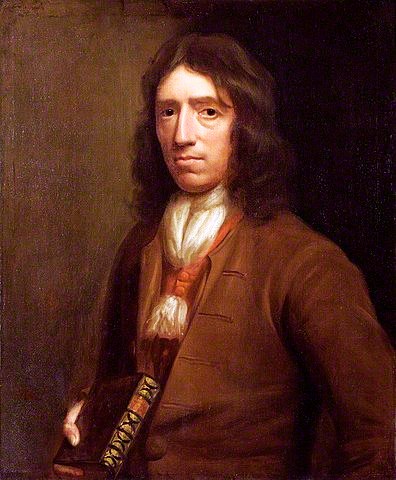 Few
pirates actually married. Out of a sampling of 521,
only twenty-three had wives. Those convicted of
their crimes often asked for their parents’
forgiveness, but rarely mentioned wives and
children. There were exceptions, though. In 1709,
forty-seven women and others kinsmen petitioned
Queen Anne to pardon the pirates of Madagascar. William
Baugh wanted to marry the daughter of Henry
Skipwith, commander of the fort at Kinsale, Ireland.
Baugh bribed Mrs. Skipwith with gifts of silverware,
linen, and canvas to gain her daughter’s hand and to
secure protection from prosecution. William
Dampier married, but rarely mentioned his wife
in his journals and spent little time in England. Stede
Bonnet supposedly became a pirate to escape
his nagging wife. Henry
Morgan and William Kidd both married and had
children. John Criss,
of Ireland, left behind three wives upon his death. Few
pirates actually married. Out of a sampling of 521,
only twenty-three had wives. Those convicted of
their crimes often asked for their parents’
forgiveness, but rarely mentioned wives and
children. There were exceptions, though. In 1709,
forty-seven women and others kinsmen petitioned
Queen Anne to pardon the pirates of Madagascar. William
Baugh wanted to marry the daughter of Henry
Skipwith, commander of the fort at Kinsale, Ireland.
Baugh bribed Mrs. Skipwith with gifts of silverware,
linen, and canvas to gain her daughter’s hand and to
secure protection from prosecution. William
Dampier married, but rarely mentioned his wife
in his journals and spent little time in England. Stede
Bonnet supposedly became a pirate to escape
his nagging wife. Henry
Morgan and William Kidd both married and had
children. John Criss,
of Ireland, left behind three wives upon his death.
The most commonly thought-of relationship between
pirates and women involved informal sexual liaisons.
Baptiste Ingle, a pirate in Captain Robert
Stephenson’s crew, came to Whiddy Island in
1612. He often made “merry with a young woman
that lay at Ballygubbin.”(Bandits at Sea) His
fellow pirates said he intended to wed the colleen,
but the wooing ended abruptly after he absconded
with £100 he stole from his comrades.
Most pirates, however, had less permanent liaisons
with women. Prostitution was a thriving business in
the ports or havens where they visited. In 1740,
Charles Leslie wrote: “Wine and women drained their
wealth to such a degree that, in a little time, some
of them became reduced to beggary. They have been
known to spend two or three thousand pieces of eight
in one night; and one gave a strumpet five hundred
to see her naked.” (Cordingly) Mary
Carleton, the German Princess, was Port
Royal’s most famous prostitute. Born in
Canterbury, England, she arrived in that city soon
after her conviction in 1671 for theft and bigamy. Zheng Yi
Sao (1775-1844) was a prostitute in Canton,
China before she married Zheng Yi in 1801, and
helped him create a powerful federation of pirates.
Not all women that consorted with pirates, however,
were prostitutes. They were legitimate “traders,
truckers or vitelers,” some of whom were widows who
acquired the business upon their husbands’ deaths. (Bandits
at Sea) Other women held jobs men did
not. An Irish seamstress received a bolt of
striped cloth in 1610 to make John Bedlake a
waistcoat. Thomas Barlowe’s wife sold beer to
pirates in Leamcon, Ireland. In nearby Long Island,
Black Dermond and his wife exchanged food for wine,
canvas, broadcloth, steel, and other goods. Three
Bantry Bay women were accused of receiving stolen
goods from Dutch pirates in 1625. Mrs. Thibault
Suxbridge operated a Dublin safe house where friends
and relatives found sanctuary from the authorities.
In July 1612, her brother, Henry Orange, stayed
almost a week until he found a ship to England.
William Baugh also stayed in the house, but fled
after he stole jewels and diamonds.
The Enemies
Pirate
Hunters
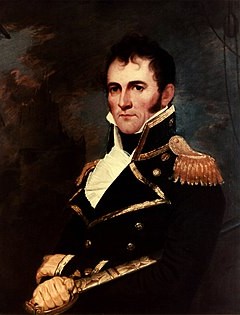 After
the golden age of Piracy ended around 1730, the
number of pirates declined dramatically, but hey did
not cease preying on unwary vessels. Significant
losses to merchants and shipowners, as well as
frequent victims’ complaints, spurred the American
and British governments to clamp down on piracy. In
1822, the United States Navy formed a special
squadron to carry out this mission. “The Mosquito
Fleet” established its base on Key West under the
command of Commodore David Porter, and within three
years, pirates ceased to plague maritime commerce in
Caribbean and American waters. Porter, however, was
not the first of the pirate hunters. After
the golden age of Piracy ended around 1730, the
number of pirates declined dramatically, but hey did
not cease preying on unwary vessels. Significant
losses to merchants and shipowners, as well as
frequent victims’ complaints, spurred the American
and British governments to clamp down on piracy. In
1822, the United States Navy formed a special
squadron to carry out this mission. “The Mosquito
Fleet” established its base on Key West under the
command of Commodore David Porter, and within three
years, pirates ceased to plague maritime commerce in
Caribbean and American waters. Porter, however, was
not the first of the pirate hunters.
Perhaps the best known was Lieutenant Robert
Maynard of HMS Pearl. His target? Blackbeard!
Virginia Governor Alexander
Spotswood authorized the expedition, and he
thought Maynard “an experienced officer and a
gentleman of great bravery and resolution.”
(Cordingly) If successful, the lieutenant and
his men would receive “. . . For Edward Teach,
commonly called Captain Teach, or Blackbeard, 100
Pounds, for every other Commander of a Pyrate Ship,
Sloop, or Vessel, 40 pounds; for every Lieutenant,
Master, or Quarter-Master Boatswain, or Carpenter,
20 Pounds; for every other inferior Officer, 15
Pounds, and for every private Man taken on Board
such Ship, Sloop, or Vessel, 10 Pounds.” (Cordingly)
According to the Boston
News-Letter, “Maynard and Teach . . .
begin the fight with their swords, Maynard making a
thrust, the point of his sword went against Teach’s
cartridge box, and bended it to the hilt. Teach
broke the guard . . . and wounded Maynard’s fingers
but did not disable him, whereupon he jumped back
and threw away his sword and fired his pistol which
wounded Teach . . . one of Maynard’s men being a
Highlander, engaged Teach with his broad sword, who
gave Teach a cut on the neck, Teach saying well done
lad; the Highlander replied, If it be not well done,
I’ll do it better. With that he gave him a second
stroke, which cutt off his head, laying it flat on
his shoulder.” (Cordingly)
Another pirate hunter succeeded in capturing several
notorious pirates of the golden age, but few know
his name. Captain Jonathan
Barnett attacked the pirate sloop late in the
evening of 22 October 1720. “. . . [T]he women
screamed, fighting like hellcats as they shot their
pistols and swung their cutlasses, refusing to give
up peacefully.” (Eastman) In the end, however,
Barnett and his men subdued Calico Jack
Rackham, Anne Bonny,
Mary Read,
and the other pirates in the crew and returned them
to Jamaica to await trial.
.jpg)
Benjamin Cole's depiction of
Anne Bonny and Mary Read from A
General History of the Robberies and Murders
of the Most Notorious Pyrates
(Source: Wikimedia
Commons)
Bartholomew
Roberts, one of the most successful pirates,
met a different fate when he and his men tangled
with the British Royal Navy off the coast of Africa
in 1725. HMS Swallow, under the command of
Captain Chaloner Ogle, fired her guns loaded with
grapeshot that “. . . struck him [Roberts] directly
on the Throat. He settled himself on the Tackles of
a Gun, which one Stephenson, from the Helm,
observing, ran to his Assistance, and not perceiving
him wounded, swore at him, and bid him stand up, and
fight like a Man; but when he found his Mistake . .
. he gushed into Tears . . . .” (Defoe) Roberts’s
crew “threw him over-board, with his Arms and
Ornaments on, according to the repeated Request he
made in his Life-time.” (Defoe) For ending Roberts’s
reign of terror, Captain Ogle received a knighthood.
Once her ships from the New World became targets,
Spain instituted its own measures to curb piracy and
smuggling. For thirty-two years, beginning in 1667,
the Armada de Barlovento patrolled the sea
while the Guardacosta watched the coasts of
Spanish-held islands in the West Indies. They
weren’t supposed to venture far from port, but Spain
often failed to pay these privateers, and so they
took “all ships that have on board any frutos de
esas Iandis [fruits of these Indies]” and
“committed barbarous cruelties and injustices, and
better cannot be expected, for they are . . . a
mongrel parcel of thieves and rogues that rob and
murder all that come into their power without the
least respect to humanity or common justice.”
(Governor Thomas
Lynch in letter to superiors in London, 1684,
Marley)
Not all Guardacosta were like the pirates
themselves. Pedro de Castro patrolled the Gulf of
Mexico. He helped to roust the logwood cutters, many
of whom were pirates, from Laguna de Términos in
1680. Almost two decades earlier, Esteban de Hoces
and Juan González Perales captured numerous vessels,
including the pirate ship Cabellero Romano.
Another pirate hunter was Mateo Alonso de Huidobro
of the Spanish navy. His 218-ton frigate helped to
corner Henry Morgan’s flotilla during the
buccaneer’s raid on Maracaibo in 1669. Fourteen
years later, de Huidobro attended a banquet in
Veracruz while two unknown ships lurked nearby. The
governor, who believed the vessels to be peaceful
merchantmen from Caracas, disregarded de Huidobro’s
warning about pirates. In actuality, the ships were
captured Spanish prizes under the commands of Laurens de
Graaf and Jan Willems.
The pirates disembarked 800 men near Veracruz that
night, and before dawn surprised the garrison. De
Huidobro rallied the guards at the governor’s
palace, but was slain on 18 May.
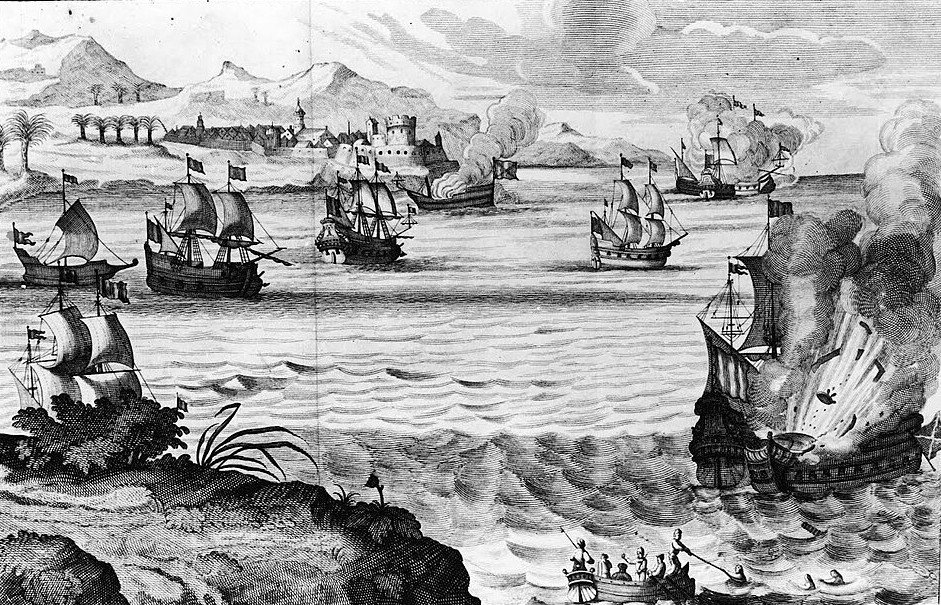
Henry Morgan's destruction of
the Spanish fleet at Maracaibo in 1669
(Source: Wikimedia
Commons)
Although some hunters were naval personnel, reformed
pirates also hunted their own kind. One such example
was Benjamin
Hornigold, a fierce and proficient pirate who
sought haven in New
Providence in the Bahamas. His fellow pirates
held him in high esteem, and he trained many,
including Blackbeard, to follow in his footsteps.
Hornigold took the king’s pardon in 1718, and
thereafter ruthlessly hunted pirates who refused to
change their ways. After he captured Charles
Vane’s sloop, Governor Woodes
Rogers wrote: “Captain Hornigold having proved
honest, disobliged his old friends by seizing this
vessel and it divides the people here and makes me
stronger than I had expected.” (Lee) Although he
failed to capture Vane, Hornigold did bring in John
Auger and seven others, who eventually were hanged
for their crimes.
Government
Officials
The commissions to hunt
pirates came from colonial governors, who abhorred
piracy. When Sir Thomas Lynch became governor of
Jamaica, he arrested his predecessor, Sir Thomas
Modyford, for authorizing the raid on Panama,
and Henry Morgan, for carrying out the attack. Both
were sent to England, where Modyford spent two years
in prison, but Morgan’s influential friends gained
his release. When news of Modyford’s imprisonment
reached the pirates, they avoided Jamaica. Three
years later, Morgan returned with a knighthood and
an appointment as lieutenant governor of the island.
Lynch resigned and left Jamaica. In 1682, King
Charles II reappointed Lynch as governor and he once
again pursued pirates. After a jury acquitted Joseph
Bannister of piracy, Lynch became so
exasperated he succumbed a week later.
From time to time, England sent officials to her
colonies to assess the corruptness of government
officials. Edmund
Randolph, a surveyor-general of Customs in
America, found that almost every governor and
official wasn’t “fit for Office” and every colony
was “a Receptacle of Pyrates.” He named two
exceptions, Virginia and her governor, who were
“truly zealous to suppress Pyracy and illegal
Trade.” (Marx) In 1699, Governor Nicholson
issued an arrest warrant for several pirates: “Tee
Wetherly, short, very small, blind in one eye, about
eighteen; Thomas Jameson, cooper, Scot, tall,
meagre, sickly look, large black eyes, twenty;
William Griffith, short, well set, broad face,
darkest hair, about thirty.” (Marx) The following
year, Nicholson played a significant role in
bringing to justice the French pirate Louis
Guittar and seventy others.
John Valentine of Rhode Island believed “[t]his sort
of Criminals are engag’d in a perpetual War with
every Individual” and prosecuted thirty-six pirates
in 1723. Five years earlier, South Carolina’s
Attorney General Richard Allen defined piracy as “a
Crime so odious and horrid in all its Circumstances,
that those who have treated on that Subject have
been at a loss for Words and Terms to stamp
sufficient Ignominy upon it.” (Rediker)
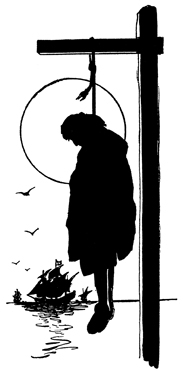 As the governor of
Jamaica, Sir Nicholas Lawes presided over the trials
of Calico Jack Rackham (16-17 November 1720) and
Anne Bonny and Mary Read (28 November 1720). Serving
on the court with Lawes were five counselors, a
chief justice, two naval captains, the
receiver-general, the secretary, and the collector.
After explaining how and why Lawes had the right to
assemble the court, the register read the charges
against Bonny and Read. Once the accused pled not
guilty, he called witnesses to prove otherwise.
Although not permitted to be represented by counsel,
the accused could call witnesses on their behalf, or
ask questions of prosecution witnesses. Bonny and
Read opted to do neither. The court deliberated
their fates in the presence of the register, then
reconvened. Lawes pronounced their sentences: “You .
. . are to go from hence to the place from whence
you came, and from thence to the place of execution;
where you shall be severally hanged by the neck till
you are severally dead. And God of his infinite
mercy be merciful to both your souls.” (Cordingly) As the governor of
Jamaica, Sir Nicholas Lawes presided over the trials
of Calico Jack Rackham (16-17 November 1720) and
Anne Bonny and Mary Read (28 November 1720). Serving
on the court with Lawes were five counselors, a
chief justice, two naval captains, the
receiver-general, the secretary, and the collector.
After explaining how and why Lawes had the right to
assemble the court, the register read the charges
against Bonny and Read. Once the accused pled not
guilty, he called witnesses to prove otherwise.
Although not permitted to be represented by counsel,
the accused could call witnesses on their behalf, or
ask questions of prosecution witnesses. Bonny and
Read opted to do neither. The court deliberated
their fates in the presence of the register, then
reconvened. Lawes pronounced their sentences: “You .
. . are to go from hence to the place from whence
you came, and from thence to the place of execution;
where you shall be severally hanged by the neck till
you are severally dead. And God of his infinite
mercy be merciful to both your souls.” (Cordingly)
A sentence of death required the building of a
scaffold for the hanging of the prisoners. John
Eles, a carpenter, built five between September 1724
and May 1725. His services cost the government £25.
Not all pirates danced the hempen jig. Just before
the signal to hang nine
pirates who had taken the king’s pardon but
returned to their lives of crime, Governor Woodes
Rogers “thought fit to order George Rounsivel to be
untied, and when brought off the stage, the butts
having ropes about them were hauled away, upon which
the stage fell and the eight swang off.” (Cordingly)
Witnesses
A trial inevitably meant
victims of piracy testified against the pirates who
had attacked them. Thomas Spenlow of Port Royal
testified against Rackham and his crew. After the
pirates had fired upon Spenlow’s schooner, they
“boarded him, and took him; and took out of the said
schooner, fifty rolls of tobacco, and nine bags of
piemento and kept him in their custody about
forty-eight hours, and then let him and his schooner
depart.” (Cordingly) Two French witnesses, through
an interpreter, testified, “That Ann Bonny . . .
handed Gun-powder to the Men, That when they saw any
Vessel, gave Chase, or Attacked, they wore Men’s
Cloaths; and, at other Times, they wore Women’s
Cloaths; That they did not seem to be kept, or
detain’d by Force, but of their own Free-Will and
Consent.” (Eastman) One of the most damaging
witnesses against the lady pirates was Dorothy
Thomas. “[T]he…prisoners at the bar, were then on
board the said sloop, and wore mens jackets, and
long trousers, and handkerchiefs tied about their
heads . . . each . . . had a machet and pistol in
their hands, and cursed and swore at the men, to
murder the deponent . . . to prevent her coming
against them . . . .” She knew they were women
“by the largeness of their breasts.” (Cordingly)
Sometimes a witness provided key evidence that
altered the court’s opinion of the guiltiness of the
prisoner before them. After pirates captured Aaron Smith,
they forced him to go on the account. He eventually
escaped but was arrested and tried as a pirate three
times (once in Cuba and twice in England). At one
trial, he called Miss Sophia Knight, his fiancée as
a witness. Holding a letter, she wept as she
testified. “I have been intimately acquainted with
the prisoner for more than three years. This letter
is from him. It is the last that ever reached me. It
is dated Oct., 1821. After the date of the letter, I
expected on the prisoner arriving in England that I
should become his wife. It was so arranged.” (Captured
by Pirates) The jury found Smith not guilty.
Later, he returned to the sea and pirates almost
captured him again.
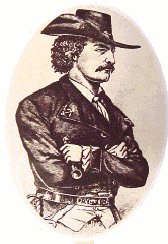 Another witness against
pirates, one who usually didn’t testify, was the
informer. Some sought revenge for a slight; others
thought it their civic responsibility. Most did it
for a price. Such was the case involving Jean
and Pierre
Laffite in Louisiana in 1811. “The informant
told Gregory [Lieutenant Francis Gregory, commander
of Gunboat No. 162] of the privateers routes and
said he expected some pirogues to be leaving the
coast shortly with prize goods . . . .”
(Davis) Gregory followed up on the lead, and
even though the pirates escaped, he salvaged 66% of
the prize vessel’s cargo, which included “more than
6,300 packages of writing paper” and brandy. (Davis) Another witness against
pirates, one who usually didn’t testify, was the
informer. Some sought revenge for a slight; others
thought it their civic responsibility. Most did it
for a price. Such was the case involving Jean
and Pierre
Laffite in Louisiana in 1811. “The informant
told Gregory [Lieutenant Francis Gregory, commander
of Gunboat No. 162] of the privateers routes and
said he expected some pirogues to be leaving the
coast shortly with prize goods . . . .”
(Davis) Gregory followed up on the lead, and
even though the pirates escaped, he salvaged 66% of
the prize vessel’s cargo, which included “more than
6,300 packages of writing paper” and brandy. (Davis)
Preachers
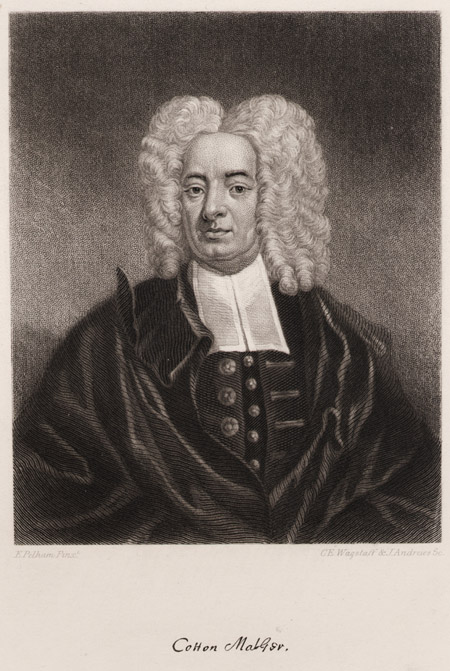 One thinks
of a minister as preaching to his flock and
comforting the sick, but some clergy added another
task to their duties – extracting confessions from
pirates and persuading them to repent before they
died. The Reverend Paul Lorrain, the Ordinary
(prison chaplain) at Newgate
Prison instructed pirates in Christianity. For
the three Sundays prior to their executions, Lorrain
preached twice a day. Of one unrepentant pirate,
Alexander Dolzell, a forty-two-year-old Scot,
Lorrain wrote, “He was so brutish and so obstinate
that he would not be satisfied with anything I
offered to him in this matter, saying, he hated to
see my face, and would not attend in the Chapel . .
. nor receive any public or private admonition from
me . . . .” (Cordingly) Just before his hanging, and
while Lorrain prayed, Dolzell repented and
apologized. One thinks
of a minister as preaching to his flock and
comforting the sick, but some clergy added another
task to their duties – extracting confessions from
pirates and persuading them to repent before they
died. The Reverend Paul Lorrain, the Ordinary
(prison chaplain) at Newgate
Prison instructed pirates in Christianity. For
the three Sundays prior to their executions, Lorrain
preached twice a day. Of one unrepentant pirate,
Alexander Dolzell, a forty-two-year-old Scot,
Lorrain wrote, “He was so brutish and so obstinate
that he would not be satisfied with anything I
offered to him in this matter, saying, he hated to
see my face, and would not attend in the Chapel . .
. nor receive any public or private admonition from
me . . . .” (Cordingly) Just before his hanging, and
while Lorrain prayed, Dolzell repented and
apologized.
Cotton
Mather, the minister of Old North Church in
Boston (1685-1722), considered pirates to be “the
Common Enemies of Mankind” and that all nations
should take whatever means were necessary to
“extirpate them out of the World.” (Rediker) Mather
often preached against piracy from his pulpit and
persuaded convicted pirates to confess. Determined
to show them the errors of their ways, he played a
significant role at both their trials and
executions. He preached daily sermons to John Quelch
and his men, and prayed with them, “and they were
catechised; and they had many occasional
exhortations.” (Cordingly) To the survivors
of Whydah, he said, “All the riches
which are not honestly gotten must be lost in a
shipwreck of honest restitution, if ever men come
into repentance and salvation.” (Cordingly) Mather
also accompanied pirates, including William
Flynn, as they walked to the scaffold and
later published their conversations in pamphlets.
Victims
Those most affected by
piracy were those who fell victim to the pirates.
Some eventually had the opportunity to see justice
done, having escaped with just the loss of their
valuables, but others weren’t so lucky. Barbary
corsairs raided Baltimore,
Ireland in 1631 and enslaved almost the entire
population – one hundred men, women, and
children. Only two victims, Joan Brodbrooke
and Ellen Hawkins, returned home after being
ransomed fifteen years later.

Christian prisoners sold into
slavery in Algerian square by Jan Luyken
(1684)
(Source: Wikimedia
Commons)
In October 1809, Chinese pirates captured more than
200 women and children from a single village. Richard
Glasspoole, already a captive, witnessed the
attack. “They were unable to escape with the men
owing to that abominable practice of cramping their
feet . . . 20 of these poor women were sent on board
the vessel I was in; they were hauled . . . by the
hair and treated in a most savage manner . . .
during [five or six days] about an hundred of the
women were ransomed; the remainder were offered for
sale . . . for 40 dollars each. . . . Several . . .
leaped overboard and drowned . . . rather than
submit to such infamous degradation.” (Bandits at
Sea)
Doña Augustin de Rojas of Portobello had the
misfortune of falling into the hands of buccaneers
in 1668. Henry Morgan had her stripped naked and
then forced her to stand in an empty wine barrel.
The buccaneers filled the barrel with powder. One of
them held a lit fuse to her face and demanded she
tell them where the treasure was hidden. Some women
endured repeated rapes, and if they survived and
returned to society, society often considered them
damaged goods.
Men, too, suffered. Several buccaneers were noted
for their cruelty, especially when dealing with
Spaniards. Alexandre
Exquemelin wrote, “Among other tortures . . .
one was to stretch their limbs with cords, and at
the same time beat them with sticks and other
instruments. Others had burning matches placed
betwixt their fingers, which were thus burnt alive.
Others had slender cords or matches twisted about
their heads, till their eyes burst out of the
skull.”
Contrary to popular belief, Blackbeard didn’t
inflict similar terrors on his victims. “If a victim
did not voluntarily offer up a diamond ring,
Blackbeard chopped it off, finger and all. This
nearly always impressed the victim, who could be
counted on to impress all to whom he related his
experience. These tactics also saved time, but their
most important function was to help spread the word
that, while Blackbeard could be merciful to those
who cooperated, woe to those who did not.” (Lee)

To learn more I suggest:
Bandits
at Sea: A Pirates Reader. New York
University, 2001.
Captured by
Pirates: 22 Firsthand Accounts of Murder and
Mayhem on the High Seas. Fern Canyon, 1996.
Cordingly, David. Under
the Black Flag. Random House, 1995.
Davis, William C. The
Pirates Laffite: The Treacherous World of the
Corsairs of the Gulf. Harcourt, 2005.
Defoe, Daniel. A
General History of the Pyrates. Dover, 1999.
Dunham, Jacob. Journal
of Voyages: Containing an Account of the
Author’s Twice Being Captured by the English
and Once by Gibbs the Pirate . . . .
Published for author, 1850.
Eastman, Tamara J.,
and Constance Bond. The Pirate Trial of Anne
Bonny and Mary Read. Fern Canyon , 2000.
Exquemelin, Alexander.
Buccaneers of America. Dover, 2000.
Gee, Joshua. Narrative
of Joshua Gee of Boston, Massachusetts, While
He was Captive in Algeria of the Barbary
Pirates. Wadsworth Atheneum, 1943.
Gottschalk, Jack A.,
and Brian P. Flanagan. Jolly Roger with an Uzi.
Naval Institute Press, 2000.
Hoffman, Paul E. Spanish
Crown and the Defense of the Caribbean,
1535-1585. LSU Press, 1980.
Konstam, Angus. The
History of Pirates. Lyons Press, 1999.
Lee, Robert E. Blackbeard
the Pirate. John F. Blair, 2002.
Marley, David F. Pirates
and Privateers of the Americas. ABC-CLIO,
1994.
Marx, Jenifer. Pirates
and Privateers of the Caribbean. Krieger,
1992.
Parker, Lucretia. Piratical
Barbarity of the Female Captive. Peter
Pauper Press: 1930.
Rediker, Marcus. Villains
of all Nations: Atlantic Pirates in the Golden
Age. Beacon, 2004.
Rogozinski, Jan. Honor
Among Thieves: Captain Kidd, Henry Every, and
the Pirate Democracy in the Indian Ocean.
Stackpole, 2000.
Rogozinski, Jan. Pirates!
Brigands, Buccaneers and Privateers in Fact,
Fiction, and Legend. Facts on File, 1995.
Smith, Aaron. The
Atrocities of the Pirates. Golden Cockerel,
1929.
Zacks, Richard. The
Pirate Hunter: The True Story of Captain Kidd.
Hyperion, 2002.
Review
Copyright ©2005 Cindy
Vallar
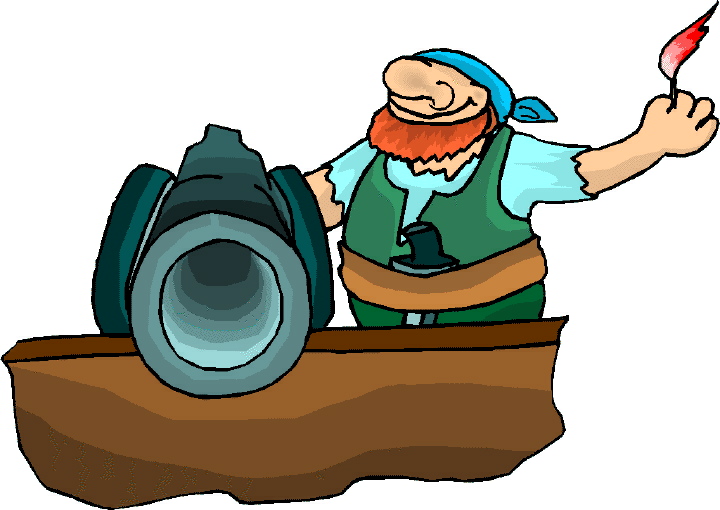
Click to contact me
Background image compliments
of Anke's Graphics |

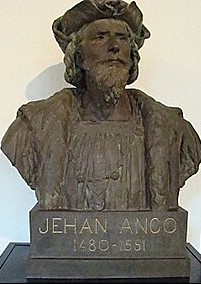
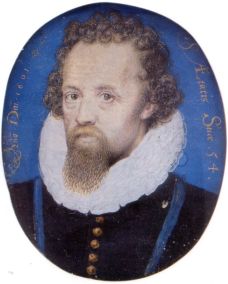
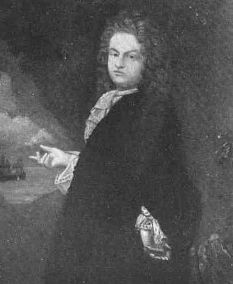
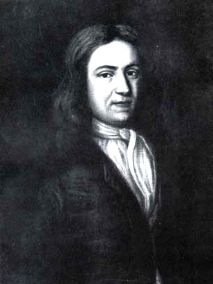
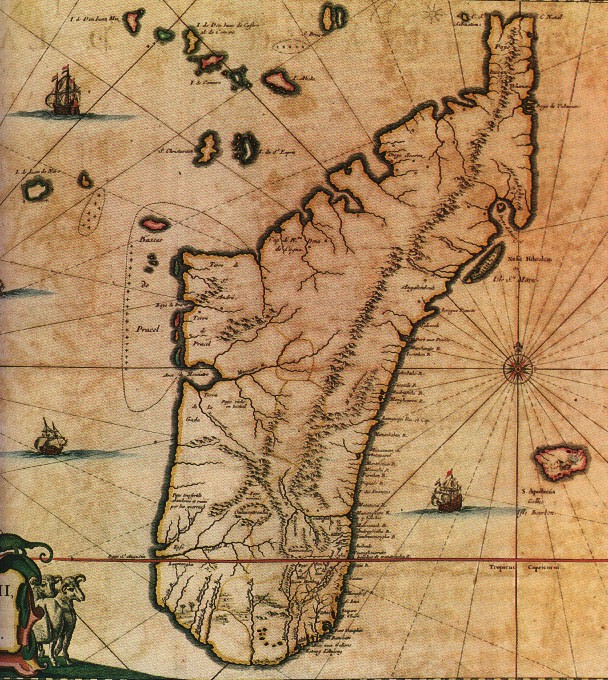
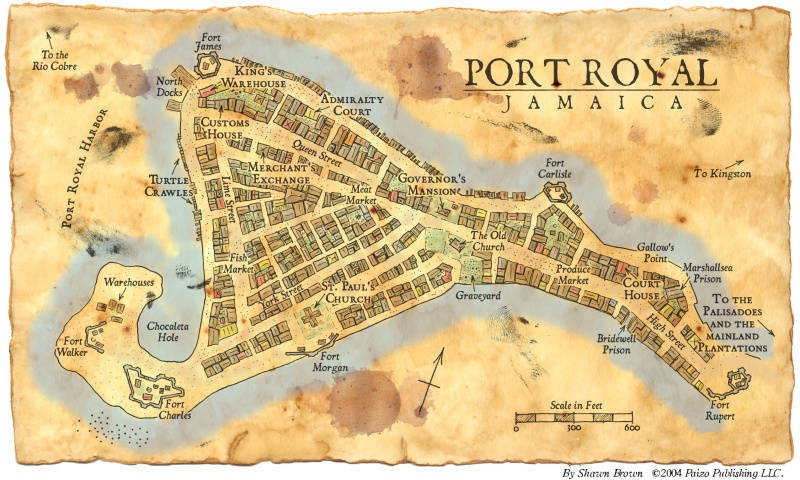
 One
frequent abuse of power stemmed from the letters of
marque the colonial governors issued.
One
frequent abuse of power stemmed from the letters of
marque the colonial governors issued. 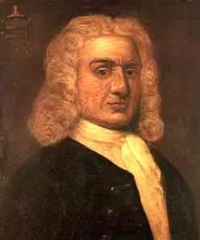
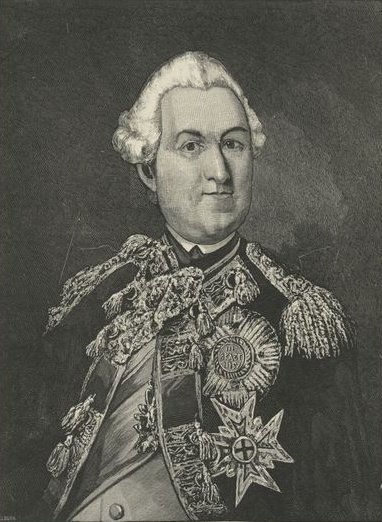
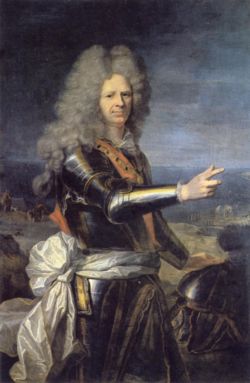
 Few
pirates actually married. Out of a sampling of 521,
only twenty-three had wives. Those convicted of
their crimes often asked for their parents’
forgiveness, but rarely mentioned wives and
children. There were exceptions, though. In 1709,
forty-seven women and others kinsmen petitioned
Queen Anne to pardon the pirates of Madagascar.
Few
pirates actually married. Out of a sampling of 521,
only twenty-three had wives. Those convicted of
their crimes often asked for their parents’
forgiveness, but rarely mentioned wives and
children. There were exceptions, though. In 1709,
forty-seven women and others kinsmen petitioned
Queen Anne to pardon the pirates of Madagascar.  After
the golden age of Piracy ended around 1730, the
number of pirates declined dramatically, but hey did
not cease preying on unwary vessels. Significant
losses to merchants and shipowners, as well as
frequent victims’ complaints, spurred the American
and British governments to clamp down on piracy. In
1822, the United States Navy formed a special
squadron to carry out this mission. “The Mosquito
Fleet” established its base on Key West under the
command of Commodore David Porter, and within three
years, pirates ceased to plague maritime commerce in
Caribbean and American waters. Porter, however, was
not the first of the pirate hunters.
After
the golden age of Piracy ended around 1730, the
number of pirates declined dramatically, but hey did
not cease preying on unwary vessels. Significant
losses to merchants and shipowners, as well as
frequent victims’ complaints, spurred the American
and British governments to clamp down on piracy. In
1822, the United States Navy formed a special
squadron to carry out this mission. “The Mosquito
Fleet” established its base on Key West under the
command of Commodore David Porter, and within three
years, pirates ceased to plague maritime commerce in
Caribbean and American waters. Porter, however, was
not the first of the pirate hunters.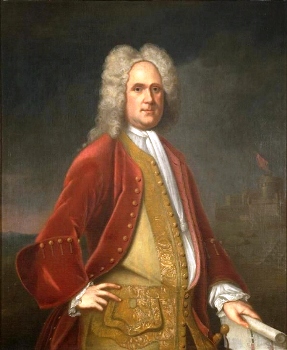
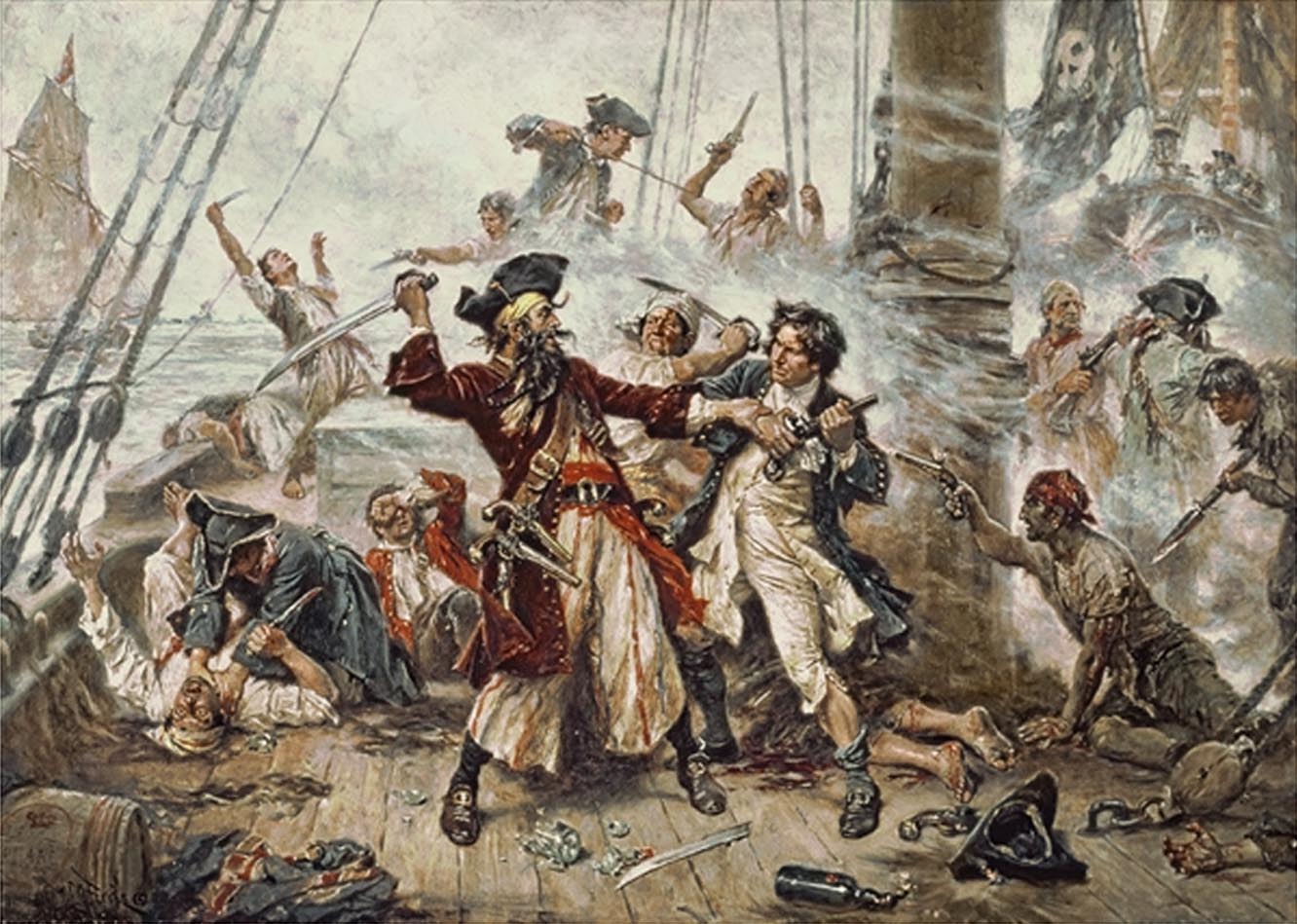
.jpg)

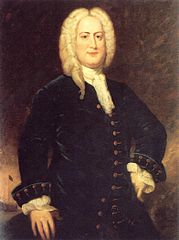

 As the governor of
Jamaica, Sir Nicholas Lawes presided over the trials
of Calico Jack Rackham (16-17 November 1720) and
Anne Bonny and Mary Read (28 November 1720). Serving
on the court with Lawes were five counselors, a
chief justice, two naval captains, the
receiver-general, the secretary, and the collector.
After explaining how and why Lawes had the right to
assemble the court, the register read the charges
against Bonny and Read. Once the accused pled not
guilty, he called witnesses to prove otherwise.
Although not permitted to be represented by counsel,
the accused could call witnesses on their behalf, or
ask questions of prosecution witnesses. Bonny and
Read opted to do neither. The court deliberated
their fates in the presence of the register, then
reconvened. Lawes pronounced their sentences: “You .
. . are to go from hence to the place from whence
you came, and from thence to the place of execution;
where you shall be severally hanged by the neck till
you are severally dead. And God of his infinite
mercy be merciful to both your souls.” (Cordingly)
As the governor of
Jamaica, Sir Nicholas Lawes presided over the trials
of Calico Jack Rackham (16-17 November 1720) and
Anne Bonny and Mary Read (28 November 1720). Serving
on the court with Lawes were five counselors, a
chief justice, two naval captains, the
receiver-general, the secretary, and the collector.
After explaining how and why Lawes had the right to
assemble the court, the register read the charges
against Bonny and Read. Once the accused pled not
guilty, he called witnesses to prove otherwise.
Although not permitted to be represented by counsel,
the accused could call witnesses on their behalf, or
ask questions of prosecution witnesses. Bonny and
Read opted to do neither. The court deliberated
their fates in the presence of the register, then
reconvened. Lawes pronounced their sentences: “You .
. . are to go from hence to the place from whence
you came, and from thence to the place of execution;
where you shall be severally hanged by the neck till
you are severally dead. And God of his infinite
mercy be merciful to both your souls.” (Cordingly) Another witness against
pirates, one who usually didn’t testify, was the
informer. Some sought revenge for a slight; others
thought it their civic responsibility. Most did it
for a price. Such was the case involving
Another witness against
pirates, one who usually didn’t testify, was the
informer. Some sought revenge for a slight; others
thought it their civic responsibility. Most did it
for a price. Such was the case involving  One thinks
of a minister as preaching to his flock and
comforting the sick, but some clergy added another
task to their duties – extracting confessions from
pirates and persuading them to repent before they
died. The Reverend Paul Lorrain, the Ordinary
(prison chaplain) at
One thinks
of a minister as preaching to his flock and
comforting the sick, but some clergy added another
task to their duties – extracting confessions from
pirates and persuading them to repent before they
died. The Reverend Paul Lorrain, the Ordinary
(prison chaplain) at 